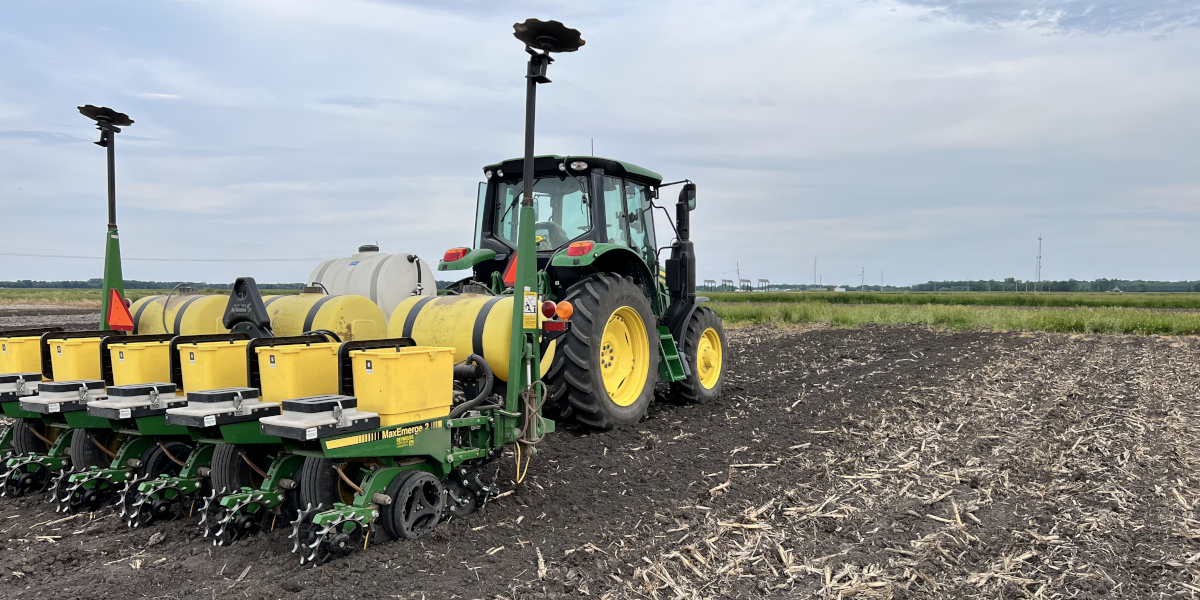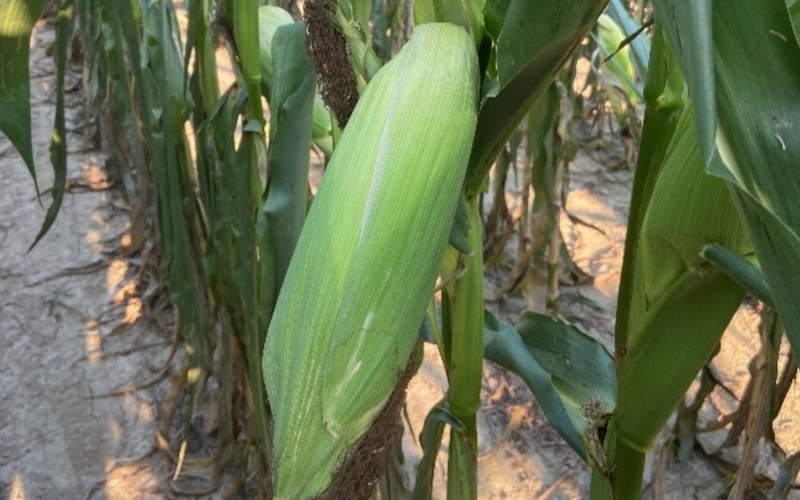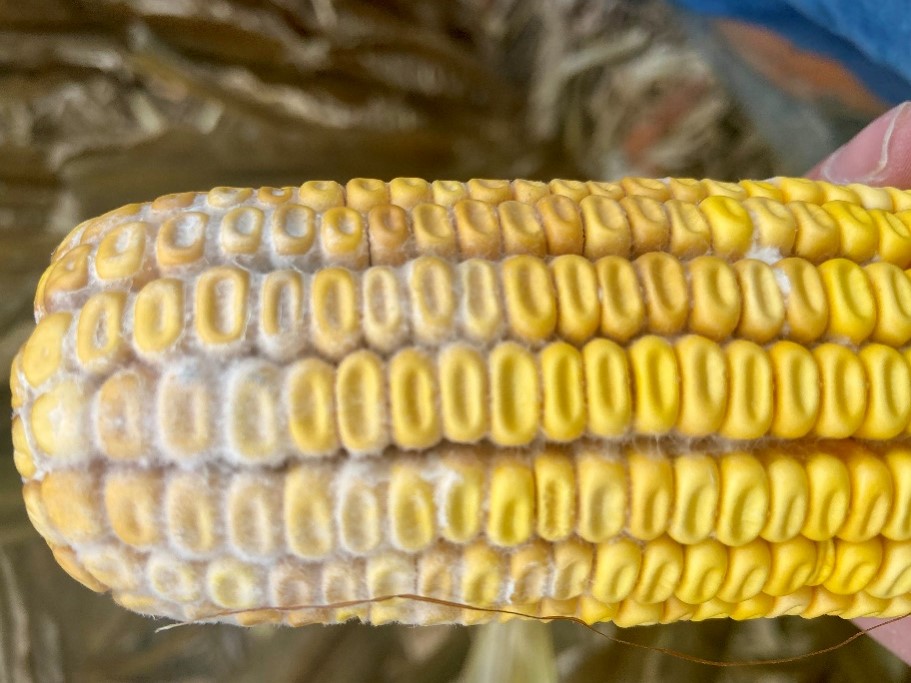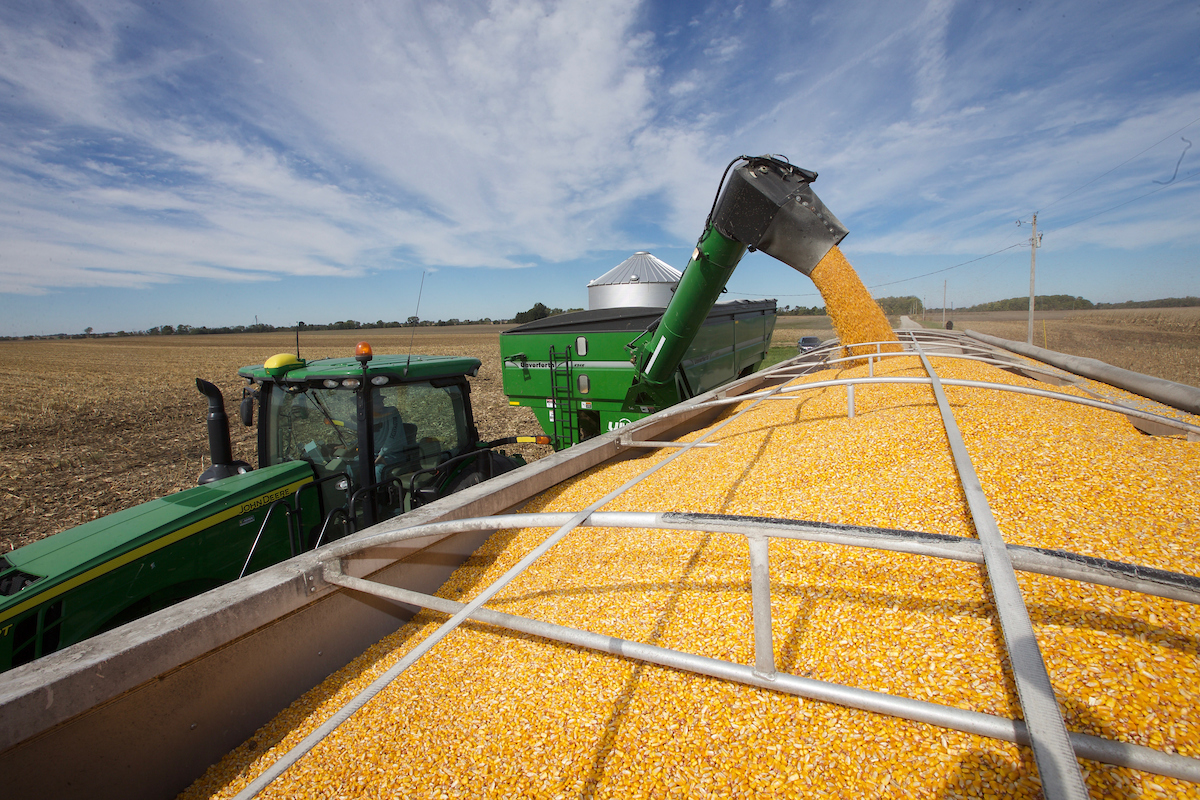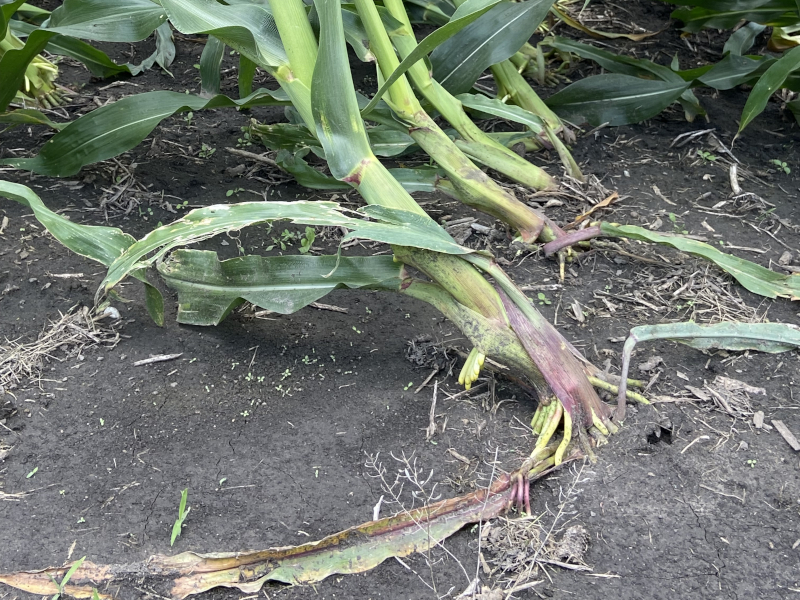Wrapped Tassels in Corn: Now What?
One of the more unusual issues showing up in Indiana corn fields this summer is “tassel wrapping”, a phenomenon where the uppermost leaves, including the flag leaf, remain tightly wrapped around the developing tassel (Figure 1). As a result, the tassel emerges late and delays pollen shed, potentially disrupting the critical timing between pollen availability and silk receptivity. Reports of tassel wrapping have come in from across Indiana, including northern, central, and southern parts of the state, and similar cases have been noted in at least nine other Midwestern states, including Iowa, Illinois, and Kansas. While it’s generating plenty of discussion among farmers and agronomists, tassel wrapping seems to be a rare occurrence and is not yet fully understood. Overall, this article summarizes current observations, possible contributing factors, and what you should look for in your fields.

Figure 1. Presence of tassel wrapping occurring in corn on July 10 (a) and July 23 (b) at the Agronomy Center for Research and Education (ACRE) in West Lafayette, IN 2025.
Tassel Wrapping vs. Twisted Whorls
The issue of “twisted whorls” or tightly wrapped leaves in corn is not a new phenomenon (Nielsen, 2019) as similar symptomology is often observed in early vegetative growth stages (e.g., V5 to V6) and is often referred to as “rapid growth syndrome”. This is a common “issue” that is observed in young corn plants as they begin the rapid vegetative growth phase and is often associated with quick shifts between weeks of slow development (cool, cloudy weather) to weeks of fast development (warm, sunny weather) often accompanied with good growing and ample soil moisture. While twisted or tightly wrapped leaves can be a common sight in early vegetative growth, tassel wrapping is unique in that it is occurring later in development or right around pollination. Like rapid growth syndrome, tassel wrapping appears to be triggered by fluctuations in temperature and moisture. In West Lafayette, for example, fields showing severe tassel wrap in early and mid-July had recently experienced large swings between hot daytime and cool nighttime temperatures, along with high humidity and rainfall events (Figures 2 and 3). Similar patterns have been observed in other states as well. For example, Licht (2025) noted that tassel wrapping in Iowa was typically seen in hybrids growing in warm, moist conditions with non-limiting nutrients, conditions that tend to accelerate vegetative growth and exacerbate leaf constriction. In addition, Ohio State agronomists suggested that a "tight flag leaf" might be a result of unusually fast growth rates ahead of tassel emergence (Karhoff et al., 2025). Overall, the most common observations and calls I have had with this issue has been specific to corn planted either in late April or early to mid-May which correspond with corn plants reaching pollination stage as these temperature fluctuations occurred.

Figure 2. Hourly air temperature (blue line) and heat index (red line) data for the Agronomy Center for Research and Education (ACRE) in West Lafayette, IN 2025 from July 3 to July 14.

Figure 3. Hourly air temperature (blue line) and heat index (red line) data for the Agronomy Center for Research and Education (ACRE) in West Lafayette, IN 2025 from July 14 to July 24.
It's Not Just the Weather
Hybrid-specific differences have also emerged as a key factor. In multiple side-by-side field comparisons, one hybrid showed significant tassel wrapping while an adjacent hybrid (planted on the same day) did not. These responses appear to vary not just across brands, but across specific hybrid numbers within brands. Planting date may also play a role as most tassel wrapping reports have come from corn planted in late April through mid-May, with symptoms showing up as those fields entered pollination. Another observation that both myself and some of my colleagues (Licht, 2025) have made is that tassel size, specifically the size of the primary vertical branch of the hybrid may be contributing to the severity of the tassel wrapping (Figure 4). Hybrids with large, wide central tassel branches may struggle more to break through tightly wrapped upper leaves, increasing the likelihood of wrapping occurrence and pollen shed delays.

Figure 4. Tassel size and morphology differences between a hybrid without observed tassel wrapping (a) and a hybrid with significant tassel wrapping (b). The tassel on the right (b) exhibited a larger (wider and longer) main, vertical tassel branch in comparison to the tassel on the left (a).
What are the Yield Implications?
One of the key questions surrounding tassel wrapping is its potential impact on pollination and yield. The primary concern is poor pollination, specifically, ovules on the ear failing to fertilize, resulting in missing kernels. The challenge is that the severity of pollination issues appears to vary widely, even within the same location. I’ve observed fields with significant tassel wrapping with no apparent pollination issues alongside others showing ears with up to 25% unfertilized ovules. For that reason, it’s essential to begin scouting now, especially in fields where tassel wrapping was observed. Gently pull back husks and examine ears for pollination success. Look for missing kernels or areas where silks remain attached; silks that detach easily from the cob typically indicate successful fertilization (Figure 5).
The core problem with wrapped tassels is the disruption of timing between silk emergence and pollen shed. Under dry soil conditions, we often see delayed silk emergence, which can result in poor pollination at the tip of the ear (since the last silks to emerge correspond to the tip). In contrast, tassel wrapping can cause the opposite problem as silks emerge on time or early, but pollen shed is delayed, leading to poor pollination at the base of the ear (first silks to emerge align with the base). Another issue is that delayed pollen shed can also result in excessively long silks (Figure 5), which continue to grow for 9 to 10 days unless pollinated (Nielsen, 2018). These long silks can crowd or “shade” one another, further inhibiting successful pollination.
Another factor complicating the issue is that modern hybrids tend to silk earlier than they used to, an intentional breeding improvement aimed at enhancing stress tolerance. While early silking can be beneficial in stressful environments, it may pose a problem under optimal growing conditions, and especially when tassel emergence is delayed due to wrapping. In some cases, hybrids are silking too early due to the strong environmental conditions, and the lack of timely pollen shed due to wrapped tassels only exacerbates the issue. Ultimately, successful pollination in corn comes down to timing. Corn only pollinates over a short window, typically 10 to 14 days. In addition, silks remain receptive to pollen up to 10 days, but the receptivity declines over this period and peak receptivity is often only 4 to 5 days after silk emergence. Therefore, any disruption in the synchrony between pollen shed and silk emergence, such as that caused by tassel wrapping, increases the risk of poor pollination and potential yield loss.

Figure 5. Corn ear with poor pollination (non-detached silks) at the base of the corn ear (first silks to emerge from the husk) (a) and the presence of excessively long silks (b) which can be an indication of early silk emergence and delayed pollen drop.
What Should You Do?
- Scout fields now – especially those planted in late April to mid-May or those with known tassel wrap issues.
- Check for pollination success – carefully pull husks back and look for missing kernels or silks that remain attached to the cob (a sign of failed fertilization).
- Document hybrid, planting date, and field conditions – These details may help pinpoint contributing factors.
- Report observations – Share what you’re seeing with your local Extension office or directly with me. The more data we collect, the better we can understand this emerging issue.
Tassel wrapping in corn is an unusual and poorly documented phenomenon, but early signs point to it being triggered by environmental conditions, temperature fluctuations, hybrid differences, and plant developmental timing. While not every field is showing yield loss, the risk may be significant in areas with severe tassel wrap and poor pollination synchrony. Overall, this article reflects what we’ve seen so far in Indiana and across the Midwest in 2025. As the season progresses, we’ll continue to collect field data and update recommendations. If you’re experiencing tassel wrapping or suspect pollination problems, don’t hesitate to reach out, we’re still trying to piece this puzzle together.
Additional Information:
Nielsen, R.L. (2018). Unusually long silks in corn. Corny News Network. Purdue Univ. Ext.
Nielsen, R.L. (2019). Yellow tops and twisted whorls in corn. Corny News Network. Purdue Univ. Ext.


